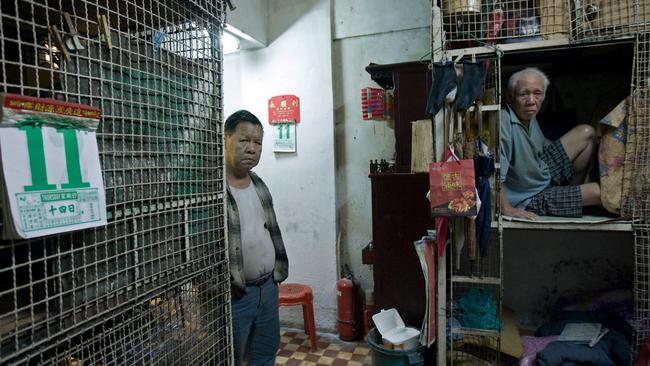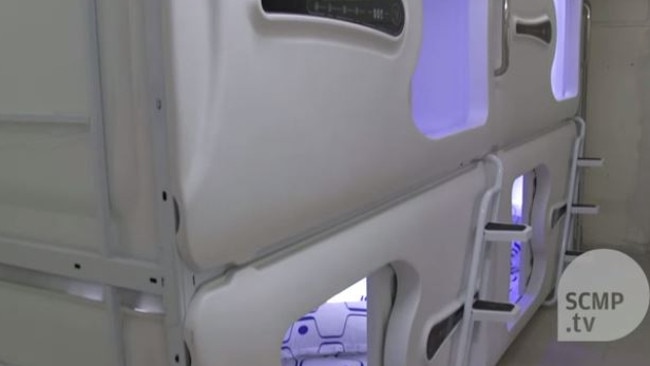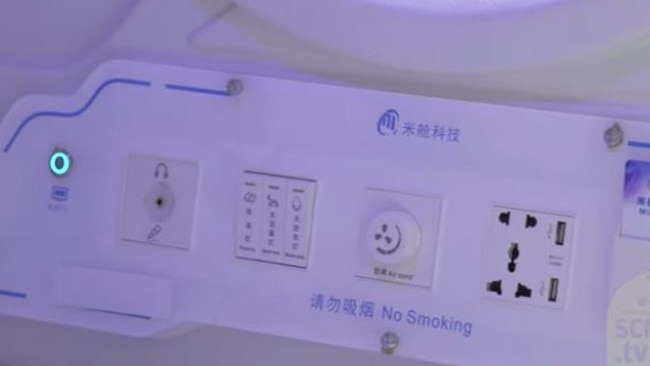Are hi-tech “sleep pods” the future of housing?
A LANDLORD in the world’s most expensive city is raking in thousands of dollars a month with a simple but popular investment.

FEEL like your home isn’t big enough? Just be glad you’re not living in Hong Kong.
While the country’s richest may live in mansions with glamorous views of city skylines, the conditions suffered by those on the other end of the spectrum will make your cramped little studio apartment sound like a palace.
Hong Kong’s poorest typically live in subdivided apartments or tiny “coffin homes” — nicknamed for their size and the sense of claustrophobia they produce.
Ventilation is typically poor, “beds” are basically just cages stacked on top of each other and hygiene is almost non-existent.

For some, their entire living space — bathroom, kitchen and bedroom combined — is in a cramped space as tiny as 1.3 square metres.
You’re literally cooking above your toilet, and swapping out a mattress for bamboo mats or old linoleum is the only way to keep bed bugs away.
Now, one entrepreneur is making hundreds of thousands of dollars in profit each month with an innovative new solution.
HOW BAD IS THE RENTING LIFE IN HONG KONG?
Hong Kong is notorious for its ridiculously high property prices.
According to the latest annual Demographia International Housing Affordability Survey, the country gets the top gong for most expensive housing market in the world.
The median home costs 19 times the median annual pre-tax household income, making it the highest multiple Demographia has measured in 12 years of conducting the survey.
The astronomical prices combined with long public housing queues have forced people into low-income housing, including “coffin homes” and subdivided units.

According to the country’s Census and Statistics Department, up to 200,000 people were cramped into 88,000 subdivided units last year — not including those living illegally in industrial buildings.
When we say “subdivided units”, we’re not talking about your average two-bedroom apartment.
In Hong Kong, a subdivided flat involves dividing the originally-approved apartment plan into multiple sections. This entails removing the non-structural partition walls, and can greatly compromise the safety and hygiene of the building.
These living spaces have been referred to as “human flesh steamers” due to the lack of windows or ventilation, and poor drainage systems.
According to the South China Morning Post, an estimated 100,000 people live in these abhorrent conditions.
While the concept sounds outrageous, it technically falls into a legal grey area due to how difficult it is to gain a warrant to inspect private property.
This means potential safety concerns can eternally go unchecked.
A SOLUTION TO THE PROBLEM
Entrepreneur and landlord Sandy Wong is reeling in thousands of dollars a month by making housing more affordable for Hong Kong’s people.
Taking Japan’s “capsule hotel” concept to the next level, he’s created a series of single-sized bed sleeping quarters which are fashioned into futuristic hi-tech pods, complete with keycard access, airconditioning and blue lighting.
Think of them as alien bunk beds, if you will.

Over the past three months, Mr Wong has rented out 51 pods in six different apartments across the city. He plans to rent out 1000 more units over the following year.
Up to 10 capsules can fit into a typical 65 square-metre apartment.
The capsule homes are about two metres long and 1.1 metres high. They come with a mattress, pillow, bedding, three different lights, outlets for charging devices and a mini fire extinguisher.
They come with a shared kitchen, bathroom and common area.

Mr Wong said his initial price was $HK2500 per month ($A420), but people online were questioning why it was so low. With the success he’s gained over the past few months, Mr Wong has now bumped the price up to $HK4500 ($A756) for a minimum one-month stay, and is making an overall profit of $HK120,000 (more than $A20,000) a month.
Mind you, it’s still more expensive than many of the “coffin homes” gaining popularity in Hong Kong, but it’s still more affordable than a potentially-dangerous subdivided flat.

Mr Wong’s typical tenant is single, employed and aged between 20 and 40. Unfortunately, this may not address the problems of those slumming in subdivided flats, who are typically unemployed, on very low incomes or new immigrants.
“The capsule homes have been very popular among young people who want a sense of privacy, a comfortable bed, but don’t want to pay so much money,” he said.
Sydney came second on the Demographia property list, with its income-to-house-price multiple climbing to 12.2 from 9.8 in 2014.
You have to wonder whether we’ll eventually be investing in hi-tech capsules of our own.



